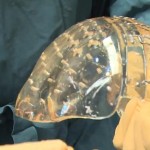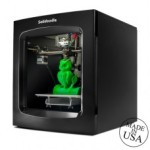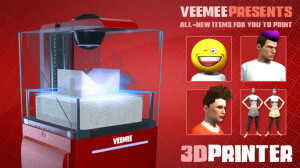3D Printers, Real and Virtual
by Phoenix, HSM team writer
We all know that 3D printing has significant potential medical applications. Some of you reading this may be familiar with the 3D printer because of VEEMEE’s 3D printer in Home, with its fabulous array of gifts personal and otherwise, but in the real world the applications for such a device are reaching amazing heights.
Recently, for instance, there was a woman in Holland who received a skull transplant.
This woman was born with a rare disease that allowed her  cranium to continue to grow; this condition would have eventually caused her death. Using a 3D printer, doctors were able to replace her cranium with a clear plastic skull, and since the surgery, her sight has returned. This replacement opens doors for other types of bone disease replacement. Provided continued studies on this transplant are favorable, this type of material could allow doctors to perform some truly phenomenal, life-saving procedures which today we would only consider to be science-fiction.
cranium to continue to grow; this condition would have eventually caused her death. Using a 3D printer, doctors were able to replace her cranium with a clear plastic skull, and since the surgery, her sight has returned. This replacement opens doors for other types of bone disease replacement. Provided continued studies on this transplant are favorable, this type of material could allow doctors to perform some truly phenomenal, life-saving procedures which today we would only consider to be science-fiction.
The recent additions from VEEMEE to Home’s 3D printer reminded me just how versatile these printers are both in Home and in the real world. There seems to be no limit to the additions this printer can create. Medical science has gone from creating 3D prosthetics, such as ears and partial facial reconstructions, to creating replacement skulls in what is a very short span of years for the field. The skull used in the transplant is made of polyetherketoneketone (PEKK); this is a thermoplastic, this plastic and its family of plastics are strong and very resistant to temperatures this is useful for sterilization purposes.
The medical requirements as well as requirements for 3D printing can be strict, and limit the possibilities of created and usable pieces currently. The skull that was used was created by an Australian company (Anatomics) and was in fact  transparent. The transparency was another plus, as it allowed viewing of the brain and it’s workings. This transplant brings even more possibility to medical applications of study with these printers. There is talk of using the printers to create skulls that can be adapted to facilitate different types of hearing implants.
transparent. The transparency was another plus, as it allowed viewing of the brain and it’s workings. This transplant brings even more possibility to medical applications of study with these printers. There is talk of using the printers to create skulls that can be adapted to facilitate different types of hearing implants.
As technology moves forward, the possibilities are almost endless for the real world’s 3D printer applications, just as they seem to be for VEEMEE’s printer. What we consider to be merely a fun toy in Home may, in time, become standard medical practice in the real world.
Share
| Tweet |



:^) It’s a fascinating technology, and yet another modern day marvel. I understand 3D printers can now even print metal in 3D, with the resulting pieces being as strong as cast metal.
Need a replacement part for that classic car? Print one out… The possibilities are endless.